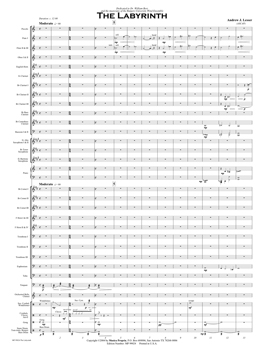Instrumentation
1 - Piccolo
4 - Flute 1
6 - Flute 2 & 3
2 - Oboe 1 & 2
1 - English Horn
1 - E♭ Clarinet
4 - B♭ Clarinet 1
4 - B♭ Clarinet 2
4 - B♭ Clarinet 3
2 - B♭ Bass Clarinet
1 - E♭ Contrabass Clarinet
1 - B♭ Contrabass Clarinet
2 - Bassoon 1 & 2
4 - E♭ Alto Saxophone 1 & 2
2 - B♭ Tenor Saxophone
1 - E♭ Baritone Saxophone
1 - Piano
3 - B♭ Cornet 1
3 - B♭ Cornet 2
3 - B♭ Cornet 3
2 - F Horn 1& 3
2 - F Horn 2 & 4
3 - Trombone 1
3 - Trombone 2
3 - Trombone 3
2 - Euphonium B. C.
2 - Euphonium T. C.
4 - Tuba
1 - Timpani
4 - Percussion 1 (Bells, Chimes,
Suspended Cymbal, Windchimes)
4 - Percussion 2 (Cymbals, Claves,
Anvil, Gong)
4 - Percussion 3 (Snare Drum, Tom-toms,
Bongos, Bass Drum)
The Labyrinth (12:00)
Grade 5
by Andrew Lesser
Dedicated to Dr. William Berz
and the musicians of the Rutgers University Wind Ensemble
Program Notes
The Labyrinth is a highly programmatic work centering on the experience of a central character, whose features and characteristics are left to the individual’s imagination. The character is about to take an arduous journey into the unknown through the medium of a giant labyrinth. The character begins the journey by staring with purpose, but apprehension, at the massive gates of the labyrinth. Slowly, the gates open, and the character is drawn inside as the gates silently close behind. Reluctantly, the character takes a few nervous steps, then growing bolder, begins to explore the seemingly infinite passageways, pathways and tunnels. After taking numerous twists, turns and backtracks, the character slowly becomes more agitated. As panic begins to set in, the character starts running down the corridors and tunnels, trying in vain to search for a familiar area. Panic finally sets in, leaving the character in a frantic search for the exit. The very walls of the labyrinth seem to close in as the character staggers through the passages, beating his/her fists against the walls. Finally, when all seems hopeless, a distant light shines through, revealing the exit. However, the gates to the opening slowly close as the character starts to frantically run toward them. In a desperate leap, the character hurdles through the opening just as the gates slam shut. The character stands once again before the labyrinth, a symbol of triumph against the massive structure of cold, dark stone.
COMPOSER’S NOTES
The main theme is presented for the first time at measure 15 in broken instrumentation starting with the French horns. It is presented by the full ensemble again at measure 45 and the horns at measure 100 before returning throughout the piece in various forms. Another motive that appears throughout the piece is the interval of a minor second followed by a perfect fourth. This motive is first presented by the alto saxophone at measure 15.
If an anvil that provides a metallic sound characterized by long duration is not available, the chimes player may use metallic mallets to scrape across the chimes horizontally.
The programmatic sequences according to the music are as follows:
m. 2 Clave is to be outside of rhythmic parameters, follow tempo markings
m. 17 Short breath mark after fermata before climax at m. 18
m. 18 Gates to the labyrinth open
m. 28 Flute solo may be rubato, returning to tempo at start of clarinet solo
m. 48 Character takes first steps into the labyrinth
m. 71 Continuous glissando by windchimes
m. 110 Agitation sets in as character begins to lose his/her way
m. 174 Panic sets in as character runs through the labyrinth trying to find the correct route
m. 256 Character becomes wild with panic as anvil symbolizes fists beating against the walls of the labyrinth
m. 333 Character sees the exit to the labyrinth
m. 337 Doors to the labyrinth begin to close as character begins frantically rushing toward them to escape
m. 359 Character escapes the labyrinth just as the doors slam shut


Home | Composers | Grade Levels | Order Form | Contact
©2010 Musica Propria, Inc.

